A Quick Presentation of the Tulip Perspective¶
Here are the components of Tulip Perspective’s main window:
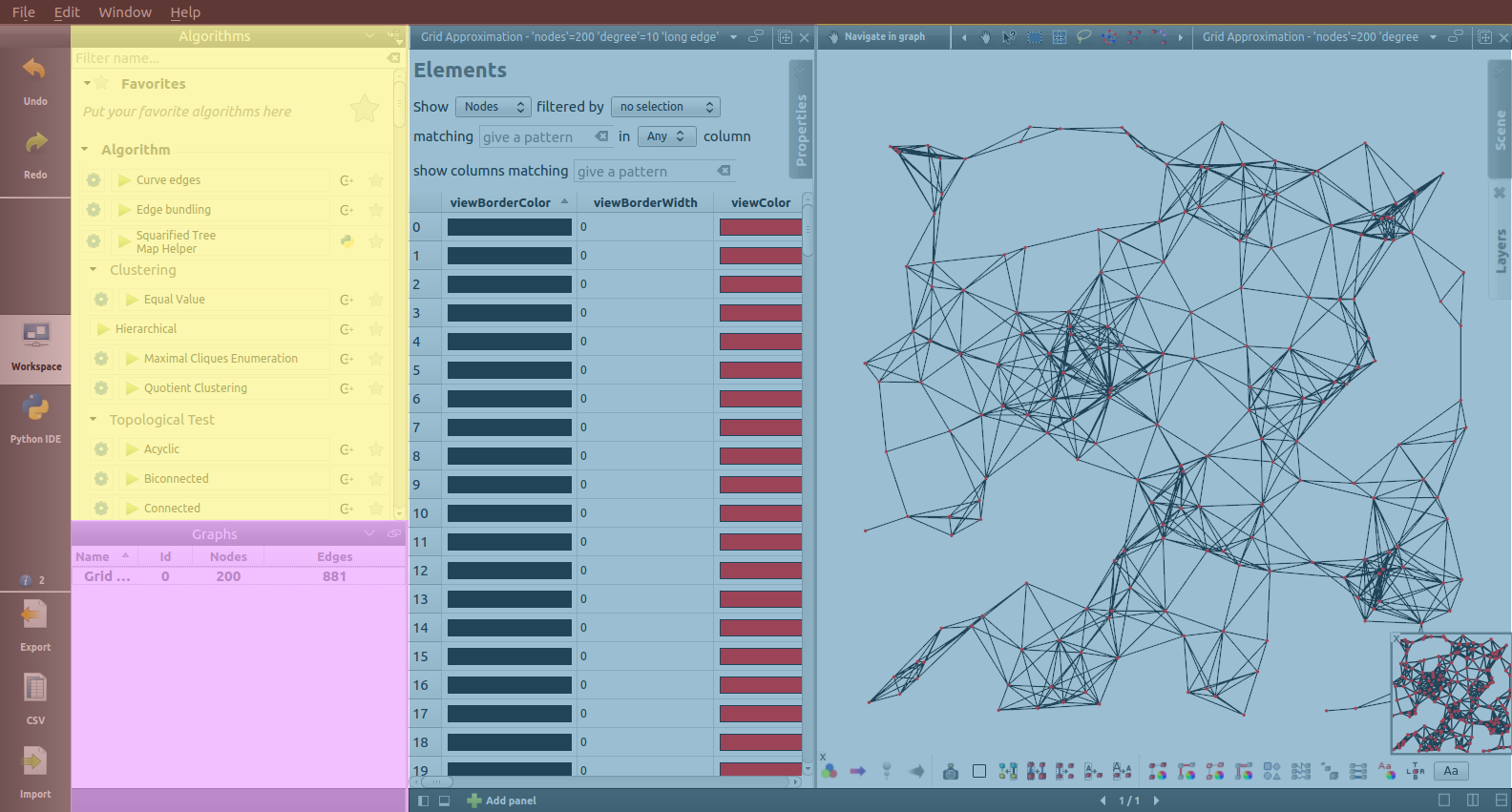
From this point and even if it is no fully correct, we refer to the Tulip perspective by simply using the term Tulip. Differentiating one (Tulip perspective) from the other (Tulip agent) is quite simple as the perspective window proposes the visualization actions and the Tulip agent window only offers plugin management and choosing the project to open.
Toolbar¶
The vertical toolbar, on the left of the main window, contains 8 buttons:
 Undo and
Undo and  Redo: allows the user to navigate through the operations performed on the graph.
Redo: allows the user to navigate through the operations performed on the graph. Panels: toggle between the display of the overviews of all created panels and the display of the workspace (more information in Workspace view).
Panels: toggle between the display of the overviews of all created panels and the display of the workspace (more information in Workspace view).
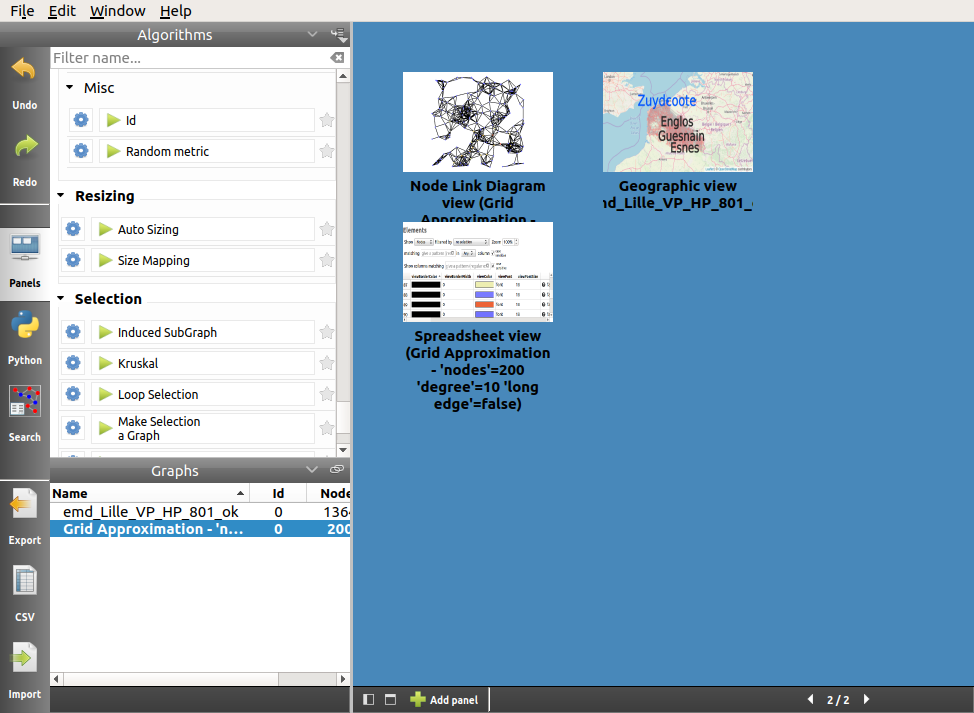
When overviews are displayed, you can then double-click on a panel icon to open it, click on the cross in the top-right corner of the icon to delete it, or click again on the Panels button to return to the views currently displayed in the workspace.
 Python: displays the Tulip python IDE (find more in Tulip Python IDE).
Python: displays the Tulip python IDE (find more in Tulip Python IDE). Search: displays the Search dialog (find more in Search).
Search: displays the Search dialog (find more in Search). Export: opens the graph exporting wizard (more in Save or Export your Work).
Export: opens the graph exporting wizard (more in Save or Export your Work). CSV: opens the CSV data importing wizard (more information in CSV Import).
CSV: opens the CSV data importing wizard (more information in CSV Import). Import: opens the graph importing wizard (learn more about it in Build a Graph).
Import: opens the graph importing wizard (learn more about it in Build a Graph). Plugins: only available on Mac and Windows platform, opens the plugins center of the Tulip agent (see in Plugins Management (Mac OS and Windows only) for more information).
Plugins: only available on Mac and Windows platform, opens the plugins center of the Tulip agent (see in Plugins Management (Mac OS and Windows only) for more information).
Algorithms panel¶
Tulip proposes several ready-to-use algorithms, offering - among others - colorization, labeling and presentation solutions.
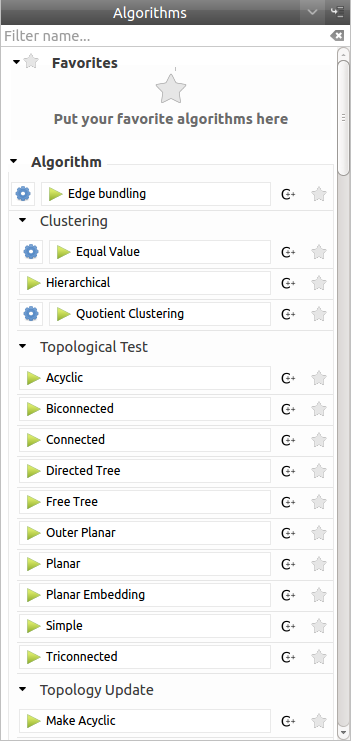
In the right corner of the title bar of this panel, you find two buttons.
The left button allows to expand/contract the contents of this panel:
 : When this icon is displayed, clicking on this button hides the content of the panel.
: When this icon is displayed, clicking on this button hides the content of the panel. : When this icon is displayed, clicking on this button shows the content of the panel.
: When this icon is displayed, clicking on this button shows the content of the panel.
Clicking on the right button displays a menu.

This menu allows to choose the storage policy for the result of property algorithms (such as measures or layout algorithms). When they are applied to a subgraph, this result can be stored:
- either in a local subgraph property (created on the fly if needed),
- or in a property already existing in the ascendant hierarchy (inherited or local).
Here are the description of the contents of the Algorithms panel:
- Filter: A search field to find the algorithms whose name or (sub) group match a given pattern.
 : keep the most useful algorithms nearby by putting them in your favorites (drag them in the favorite zone or click on
: keep the most useful algorithms nearby by putting them in your favorites (drag them in the favorite zone or click on  ).
). : most algorithms need parameters, you can display them by clicking on the gear icon.
: most algorithms need parameters, you can display them by clicking on the gear icon. : once parameters are set, just click on the algorithm name or drag and drop it on the selected graph.
: once parameters are set, just click on the algorithm name or drag and drop it on the selected graph.
Graphs panel¶
This panel gives information about the currently opened graphs.
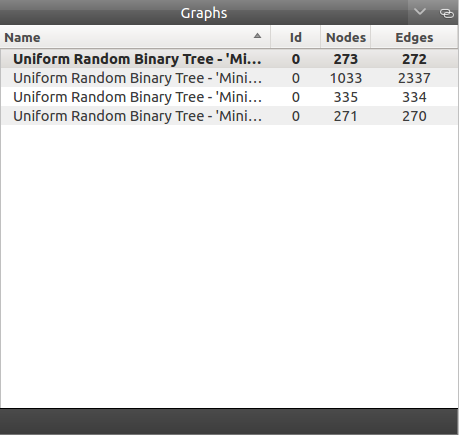
In the right corner of this title bar of this panel, you find two buttons.
The left button allows to expand/contract the contents of this panel:
 : When this icon is displayed, clicking on the button hides the panel’s content.
: When this icon is displayed, clicking on the button hides the panel’s content. : When this icon is displayed, clicking on the button shows the panel’s content.
: When this icon is displayed, clicking on the button shows the panel’s content.
Clicking on right button allows to specify the synchronization policy of the Graphs panel with the workspace active panel:
 : When this icon is displayed, it indicates that the selection of the active graph in the Graphs panel is synchronized with the selection of the graph in the workspace active panel. This means that when selecting a graph to display for this panel, it also becomes the active graph in the Graphs list and then the graph on which algorithms are applied.
: When this icon is displayed, it indicates that the selection of the active graph in the Graphs panel is synchronized with the selection of the graph in the workspace active panel. This means that when selecting a graph to display for this panel, it also becomes the active graph in the Graphs list and then the graph on which algorithms are applied. : When this icon is displayed, it indicates that the selection of the active graph in the Graphs panel is not synchronized with the selection of the graph in the workspace active panel.
: When this icon is displayed, it indicates that the selection of the active graph in the Graphs panel is not synchronized with the selection of the graph in the workspace active panel.
Users can right-click on the desired graph to open a menu proposing new options such as renaming the graph, deleting it, saving or exporting it (more in Save or Export your Work).
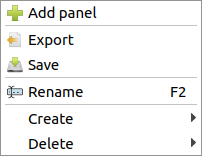
Workspace view¶
The workspace is where the visualization takes place. In this space, the user can create different panels to represent data and information.
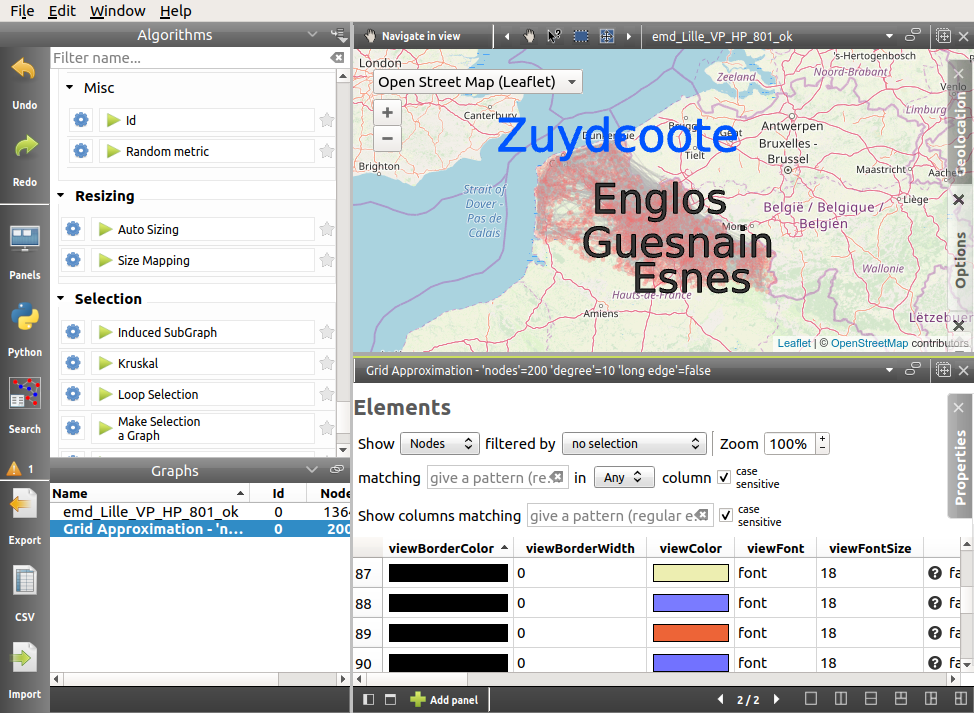
To create a new panel at least one graph must exist. Then click on the icon ![]() at the bottom left of the workspace or right-click on its name and select Add panel (both of them mentioned in Graphs panel). Otherwise, when no panel is open, you can click on the icon
at the bottom left of the workspace or right-click on its name and select Add panel (both of them mentioned in Graphs panel). Otherwise, when no panel is open, you can click on the icon  in the middle of the workspace. Each of those steps open the following window :
in the middle of the workspace. Each of those steps open the following window :
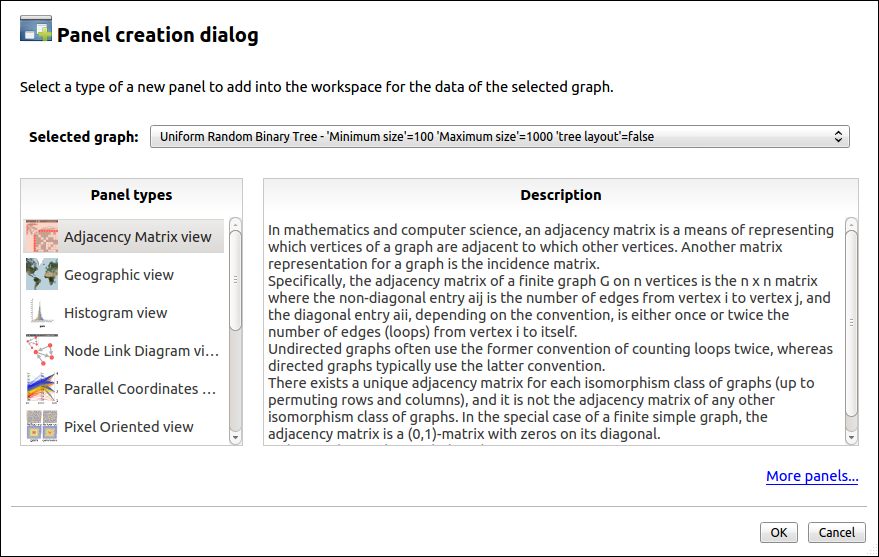
About ten panel types are available in Tulip, each of those is presented in this documentation. More information on the workspace can be found in the workspace section.
Tulip Python IDE¶
Even with more than a hundred algorithms at your disposition, you may have special needs and/or want to implement your own solutions. If you are willing to implement graph manipulation algorithms, directly heading to program a C/C++ module or plug-in can be rather tricky. Instead, Tulip proposes to use the dynamic programming language Python to easily and interactively try and implement your solutions. The Tulip Python IDE allows you to create your own scripts, plugins and modules in Python.
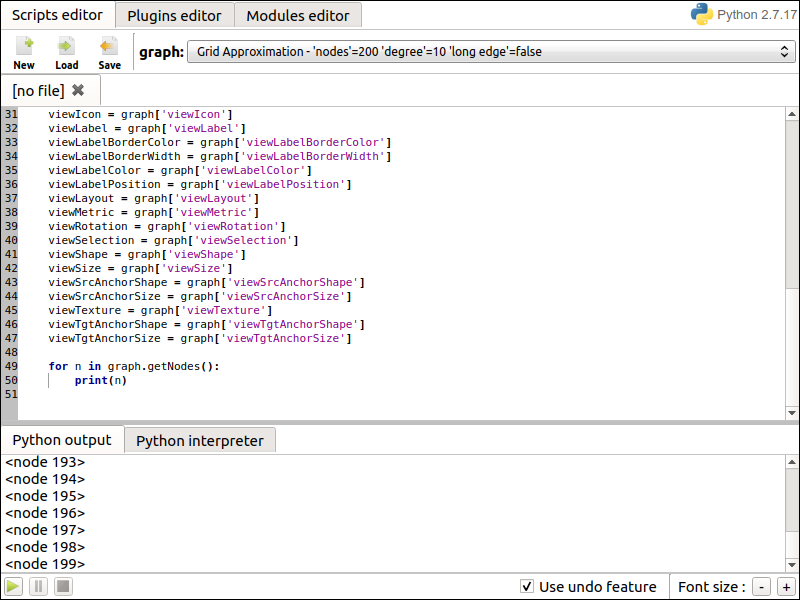
You may find more information in the Tulip Python IDE section of the Tulip Python documentation.
Search¶

The tool Search can be used in parallel of any panel. It provides a way of selecting graph’s elements according to specific criteria.
First start by selecting the graph and the elements targeted and by choosing the selection mode. The result (respecting the criteria or not) is stored in a boolean property, viewSelection by default. Then choose the values to compare and hit the button Search to launch the tool.
If the viewSelection has been selected as the result property, the selected elements are automatically enhanced in any workspace views.
Preferences¶
Tulip can be configured in several ways. The simplest way is to display the settings dialog through the Preferences item of Edit menu.
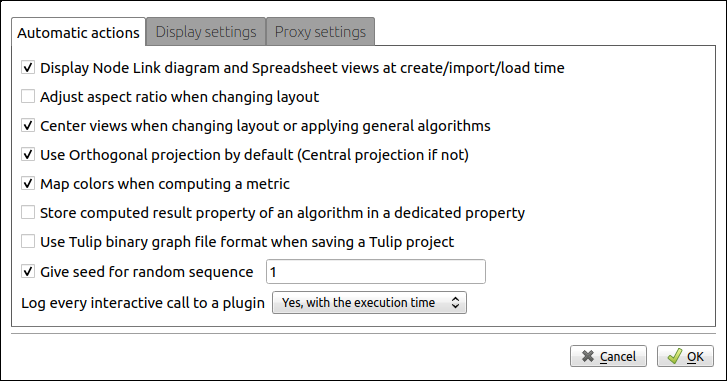
The Automatic actions tab, contains a few specific options. You can, for instance, adjust the aspect ratio when updating the layout, indicate the default projection type, automatically adapt the color according the metric being computed, display the time used to run an algorithm or indicate the graph file format to be used when saving a Tulip project.
The Display settings tab allows to choose the Display mode (Light or Dark) and to select the Drawing defaults such as the color, shape and size used for every new nodes and edges. The selection color is used to enhance the selected elements in the 3D views.
You can also change the Proxy settings such as: the socket, the host address and the port to use.




